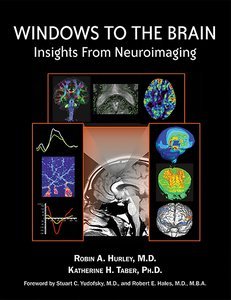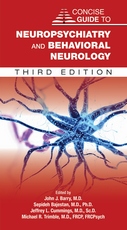Windows to the Brain
Insights From Neuroimaging
View Pricing
Description
Windows to the Brain is the only book to synthesize neuroanatomical and imaging research as it pertains to selected neuropsychiatric diseases, containing all of the Windows to the Brain papers published from 1999-2006 in the Journal of Neuropsychiatry and Clinical Neurosciences. These reader-friendly summaries by more than sixty contributors present modern imaging techniques that assist in the diagnosis of neuropsychiatric illness, enhanced by easily understood color graphics of the neuroanatomical circuits of behavior, memory, and emotion. They provide a basic understanding of how to apply a variety of imaging techniques to the study of adult neuropsychiatric disease and how to use neuroimaging to assist in diagnostic work-ups for conditions ranging from sleep disorders to epilepsy to borderline personality.
Integrated, color-coded graphics present functional anatomical information in a manner that promotes understanding and use in clinical practice, while the text encompasses a wide range of diseases and injuries across the adult lifespan. The book is organized into four sections that will help readers increase their appreciation of the wide range of research and clinical applications for imaging in neuropsychiatry: chapters on imaging techniques discuss underlying principles, strengths and weaknesses, and applications; chapters on specific diseases demonstrate a range of investigative techniques; anatomy/circuit chapters focus on particular brain structures or functional neuropsychiatric circuits; and final chapters present image-based approaches to understanding or selecting treatment options. Some of the applications described are:
- Use of fMRI in posttraumatic stress disorder to reveal the delicate balance between the structures of the emotion and memory tracks;
- Use of high-resolution MRI and nuclear imaging to distinguish between panic disorder and simple partial seizure disorder;
- Use of functional imaging studies to detect corticobasal degeneration, as a means of better understanding dementia;
- Use of newer imaging techniques in identifying progressive multifocal leukoencephalopathy, to enable more rapid and reliable tailoring of individual therapy for HIV;
- Use of functional neuroimaging in the study of fear, in order to better understand and treat anxiety-based psychiatric disorders;
- Use of neuroimaging studies in conversion disorder, showing implications for the disruption of selfhood in dissociative identity disorder and schizophrenia;
- Use of FDG-PET scans to look for predictors of treatment response in childhood-onset obsessive-compulsive disorder.
Windows to the Brain can help bring less-experienced readers up to speed on advanced imaging and anatomical details that pertain to the modern practice of neuropsychiatry. It is must-reading for specialists in neuropsychiatry and cognitive/behavioral neurology, or for general psychiatrists with an interest in neuroimaging.
Contents
- CONTRIBUTORS
- FOREWORD
- PREFACE
- Part 1: IMAGING TECHNIQUES
- Chapter 1. BLOOD FLOW IMAGING OF THE BRAIN: 50 YEARS' EXPERIENCE
- Chapter 2. FUNCTIONAL MAGNETIC RESONANCE IMAGING: APPLICATION TO POSTTRAUMATIC STRESS DISORDER
- Chapter 3. ECSTASY IN THE BRAIN: A MODEL FOR NEUROIMAGING
- Chapter 4. THE FUTURE FOR DIFFUSION TENSOR IMAGING IN NEUROPSYCHIATRY
- Chapter 5. CORTICAL INHIBITION IN ALCOHOL DEPENDENCE
- Chapter 6. APPLICATION OF MAGNETOENCEPHALOGRAPHY TO THE STUDY OF AUTISM
- Chapter 7. APPLICATIONS OF XENON COMPUTED TOMOGRAPHY IN CLINICAL PRACTICE: DETECTION OF HIDDEN LESIONS
- Chapter 8. NEW TECHNIQUES FOR UNDERSTANDING HUNTINGTON'S DISEASE
- Part 2: SPECIFIC DISEASES
- Chapter 9. SUDDEN ONSET PANIC: EPILEPTIC AURA OR PANIC DISORDER?
- Chapter 10. BIPOLAR DISORDER: IMAGING STATE VERSUS TRAIT
- Chapter 11. BLAST-RELATED TRAUMATIC BRAIN INJURY: WHAT IS KNOWN?
- Chapter 12. MILD TRAUMATIC BRAIN INJURY: NEUROIMAGING OF SPORTS-RELATED CONCUSSION
- Chapter 13. TRAUMATIC AXONAL INJURY: NOVEL INSIGHTS INTO EVOLUTION AND IDENTIFICATION
- Chapter 14. FUNCTIONAL IMAGING AS A WINDOW TO DEMENTIA: CORTICOBASAL DEGENERATION
- Chapter 15. METACHROMATIC LEUKODYSTROPHY: A MODEL FOR THE STUDY OF PSYCHOSIS
- Chapter 16. IDENTIFICATION OF HIV-ASSOCIATED PROGRESSIVE MULTIFOCAL LEUKOENCEPHALOPATHY: MAGNETIC RESONANCE IMAGING AND SPECTROSCOPY
- Chapter 17. THE EXPANDING ROLE OF IMAGING IN PRION DISEASE
- Chapter 18. APPLICATIONS OF FUNCTIONAL IMAGING TO CARBON MONOXIDE POISONING
- Chapter 19. BINSWANGER'S DISEASE: AN ONGOING CONTROVERSY
- Chapter 20. NORMAL PRESSURE HYDROCEPHALUS: SIGNIFICANCE OF MAGNETIC RESONANCE IMAGING IN A POTENTIALLY TREATABLE DEMENTIA
- Chapter 21. NEUROPSYCHIATRIC PRESENTATION OF MULTIPLE SCLEROSIS
- Part 3: ANATOMY AND CIRCUITRY
- Chapter 22. FUNCTIONAL NEUROANATOMY OF SLEEP AND SLEEP DEPRIVATION
- Chapter 23. NEURAL UNDERPINNINGS OF FEAR AND ITS MODULATION: IMPLICATIONS FOR ANXIETY DISORDERS
- Chapter 24. RABIES AND THE CEREBELLUM: NEW METHODS FOR TRACING CIRCUITS IN THE BRAIN
- Chapter 25. CONVERSION HYSTERIA: LESSONS FROM FUNCTIONAL IMAGING
- Chapter 26. THE LIMBIC THALAMUS
- Chapter 27. UNDERSTANDING EMOTION REGULATION IN BORDERLINE PERSONALITY DISORDER: CONTRIBUTIONS OF NEUROIMAGING
- Chapter 28. FUNCTIONAL ANATOMY OF CENTRAL PAIN
- Chapter 29. AN UPDATE ON ESTROGEN: HIGHER COGNITIVE FUNCTION, RECEPTOR MAPPING, NEUROTROPHIC EFFECTS
- Part 4: TREATMENT
- Chapter 30. PREDICTING TREATMENT RESPONSE IN OBSESSIVE-COMPULSIVE DISORDER
- Chapter 31. SCHIZOPHRENIA: WHAT'S UNDER THE MICROSCOPE?
- Chapter 32. SURGICAL TREATMENT OF MENTAL ILLNESS: IMPACT OF IMAGING
- INDEX
About the Authors
Robin A. Hurley, M.D., is Associate Chief of Staff at the W.G. Bill Hefner VAMC in Salisbury, North Carolina, and Associate Professor in the Departments of Psychiatry and Radiology at Wake Forest University School of Medicine, Winston–Salem, North Carolina and Baylor College of Medicine in Houston, Texas.
Katherine H. Taber, Ph.D., is a Research Health Scientist at the W.G. Bill Hefner VAMC in Salisbury, North Carolina, and Research Professor in the Division of Biomedical Sciences at the Edward Via Virginia College of Osteopathic Medicine in Blacksburg, Virginia.
Related Products
Carousel Control - items will scroll by tabbing through them, otherwise arrows can be used to scroll one item at a time








